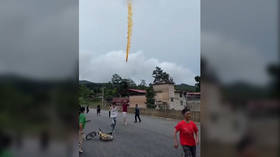Spacecraft debris falls in populated area (VIDEO)

A video apparently showing debris from a spacecraft hitting the ground in a populated area has been uploaded on Chinese social media platform Weibo.
The incident reportedly happened on Saturday during the launch of a Chinese Long March 2C carrier rocket carrying a Chinese-French satellite payload from Xichang Satellite Launch Center.
The launch site, which is solely dedicated to putting satellites into orbit, sits in a valley approximately 85km northwest of Xichang City in China’s Sichuan Province.
The clip captured what looks like a rocket booster rapidly descending from the sky while emitting dark orange smoke. Frightened locals are seen running for cover as the debris crashes into the ground behind several buildings and trees.
Parts of the spacecraft reportedly fell in Guiding County in south-central Guizhou Province, according to another post on Weibo. Sichuan Province borders Guizhou to the southeast. SpaceNews website reported that an airspace closure notice for the launch had established a temporary danger zone, which included Guiding County.
There have so far been no official reports about any casualties or property damage as a result of the incident.
The China National Space Administration (CNSA) announced on Saturday that its Long March 2C rocket had “successfully launched” a Chinese-French astronomical satellite into an orbit 600km above Earth.
🙀 Behind the scenes of SVOM launch https://t.co/Fcc0OAY3acpic.twitter.com/5fiM4oz2GY
— China 'N Asia Spaceflight 🚀𝕏 🛰️ (@CNSpaceflight) June 22, 2024
The satellite, called the Space-based Multi-band Variable Object Monitor (SVOM), was jointly developed by CNSA and France’s Centre National d’Etudes Spatiales (CNES) over the last two decades.
SVOM is intended to study Gamma-ray bursts (GRBs), which are the most violent explosive phenomena in space, capable of releasing as much energy in a few seconds as the Sun will emit over its entire 10-billion-year lifespan.
“We are looking forward to some important discoveries, such as the earliest gamma-ray bursts that occurred when the universe was still in its childhood, which will help us study cosmic evolution… special and rare gamma-ray bursts, and perhaps even... new types of bursts,” according to Wei Jianyan, who is SVOM’s principal Chinese investigator.













